2012 Hyundai Sonata Hybrid oil
[x] Cancel search: oilPage 367 of 403

Maintenance
74
7
Cleaning the upholstery and interior
trim
Vinyl
Remove dust and loose dirt from vinyl
with a whisk broom or vacuum cleaner.
Clean vinyl surfaces with a vinyl cleaner.
Fabric
Remove dust and loose dirt from fabric
with a whisk broom or vacuum cleaner.
Clean with a mild soap solution recom-
mended for upholstery or carpets.
Remove fresh spots immediately with a
fabric spot cleaner. If fresh spots do not
receive immediate attention, the fabric
can be stained and its color can be
affected. Also, its fire-resistant properties
can be reduced if the material is not
properly maintained.
Cleaning the lap/shoulder belt web-bing
Clean the belt webbing with any mild
soap solution recommended for cleaning
upholstery or carpet. Follow the instruc-
tions provided with the soap. Do not
bleach or re-dye the webbing because
this may weaken it.
Cleaning the interior window glass
If the interior glass surfaces of the vehi-
cle become fogged (that is, covered with
an oily, greasy or waxy film), they should
be cleaned with glass cleaner. Follow the
directions on the glass cleaner container.
CAUTION
Using anything but recommendedcleaners and procedures may affect the fabric’s appearance and fire-resistant properties.
CAUTION
Do not scrape or scratch the inside of the rear window. This may resultin damage to the rear window defroster grid.
WARNING
Do not wash the engine room and
trunk with water. The hybrid system
is located in engine room and
trunk. If water comes into the
engine room or hybrid battery in
trunk, electric shock or burns that
may result in serious injury or
death may occur.
Page 376 of 403
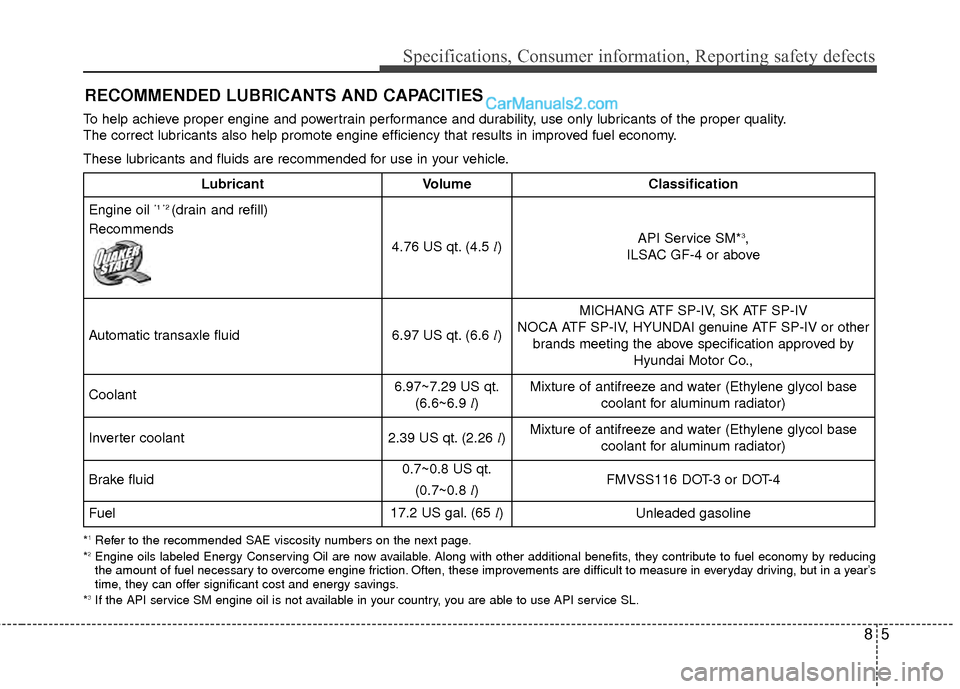
85
Specifications, Consumer information, Reporting safety defects
RECOMMENDED LUBRICANTS AND CAPACITIES
To help achieve proper engine and powertrain performance and durability, use only lubricants of the proper quality.
The correct lubricants also help promote engine efficiency that results in improved fuel economy.
These lubricants and fluids are recommended for use in your vehicle.
*1Refer to the recommended SAE viscosity numbers on the next page.
*2Engine oils labeled Energy Conserving Oil are now available. Along with other additional benefits, they contribute to fuel econo my by reducing
the amount of fuel necessary to overcome engine friction. Often, these improvements are difficult to measure in everyday driving, but in a year’s
time, they can offer significant cost and energy savings.
*
3If the API service SM engine oil is not available in your country, you are able to use API service SL.
LubricantVolumeClassification
Engine oil *1 *2 (drain and refill)
Recommends
4.76 US qt. (4.5 l)API Service SM*3,
ILSAC GF-4 or above
Automatic transaxle fluid6.97 US qt. (6.6 l)
MICHANG ATF SP-IV, SK ATF SP-IV
NOCA ATF SP-IV, HYUNDAI genuine ATF SP-IV or other brands meeting the above specification approved by Hyundai Motor Co.,
Coolant 6.97~7.29 US qt.(6.6~6.9 l)Mixture of antifreeze and water (Ethylene glycol base
coolant for aluminum radiator)
Inverter coolant2.39 US qt. (2.26 l)Mixture of antifreeze and water (Ethylene glycol basecoolant for aluminum radiator)
Brake fluid0.7~0.8 US qt.
(0.7~0.8 l)FMVSS116 DOT-3 or DOT-4
Fuel17.2 US gal. (65 l)Unleaded gasoline
Page 377 of 403
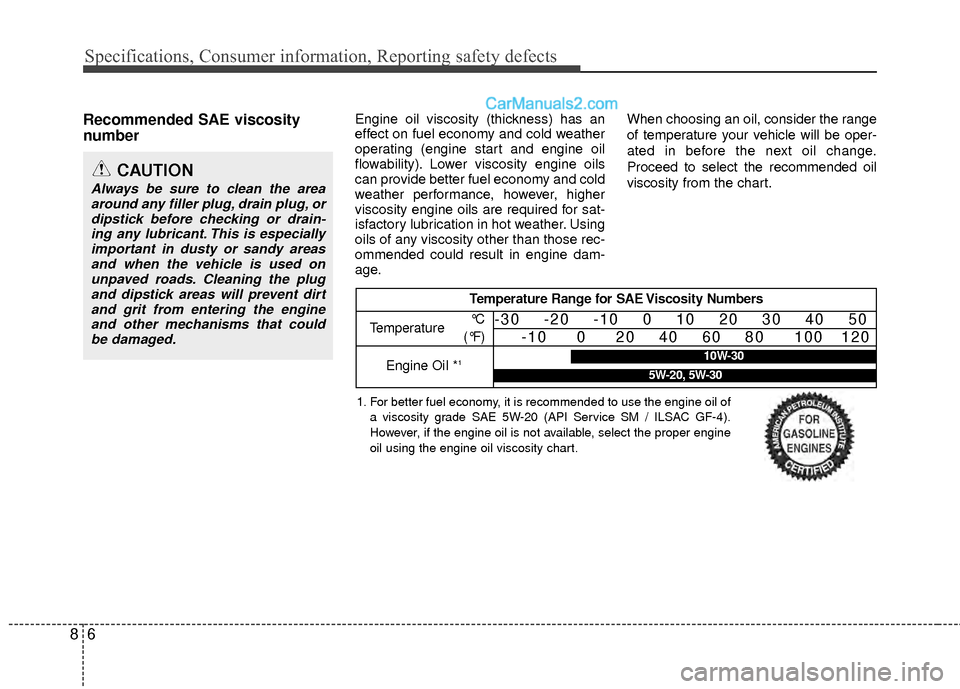
Specifications, Consumer information, Reporting safety defects
68
Recommended SAE viscosity
number Engine oil viscosity (thickness) has an
effect on fuel economy and cold weather
operating (engine start and engine oil
flowability). Lower viscosity engine oils
can provide better fuel economy and cold
weather performance, however, higher
viscosity engine oils are required for sat-
isfactory lubrication in hot weather. Using
oils of any viscosity other than those rec-
ommended could result in engine dam-
age.When choosing an oil, consider the range
of temperature your vehicle will be oper-
ated in before the next oil change.
Proceed to select the recommended oil
viscosity from the chart.
CAUTION
Always be sure to clean the area
around any filler plug, drain plug, ordipstick before checking or drain- ing any lubricant. This is especiallyimportant in dusty or sandy areasand when the vehicle is used onunpaved roads. Cleaning the plugand dipstick areas will prevent dirtand grit from entering the engineand other mechanisms that couldbe damaged.
Temperature Range for SAE Viscosity Numbers
Temperature
Engine Oil *
1
°C
(°F)-30 -20 -10 0 10 20 30 40 50 -10 0 20 40 60 80 100 120
1. For better fuel economy, it is recommended to use the engine oil of
a viscosity grade SAE 5W-20 (API Service SM / ILSAC GF-4).
However, if the engine oil is not available, select the proper engine
oil using the engine oil viscosity chart.
10W-30
5W-20, 5W-30
Page 388 of 403
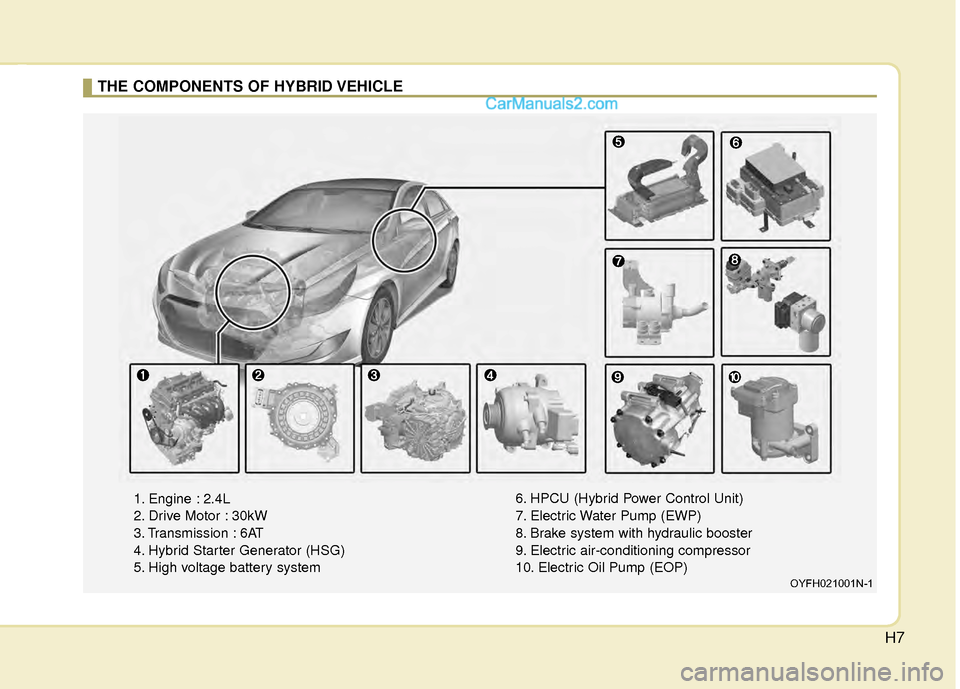
H7
THE COMPONENTS OF HYBRID VEHICLE
OYFH021001N-1
1. Engine : 2.4L
2. Drive Motor : 30kW
3. Transmission : 6AT
4. Hybrid Starter Generator (HSG)
5. High voltage battery system6. HPCU (Hybrid Power Control Unit)
7. Electric Water Pump (EWP)
8. Brake system with hydraulic booster
9. Electric air-conditioning compressor
10. Electric Oil Pump (EOP)
Page 398 of 403
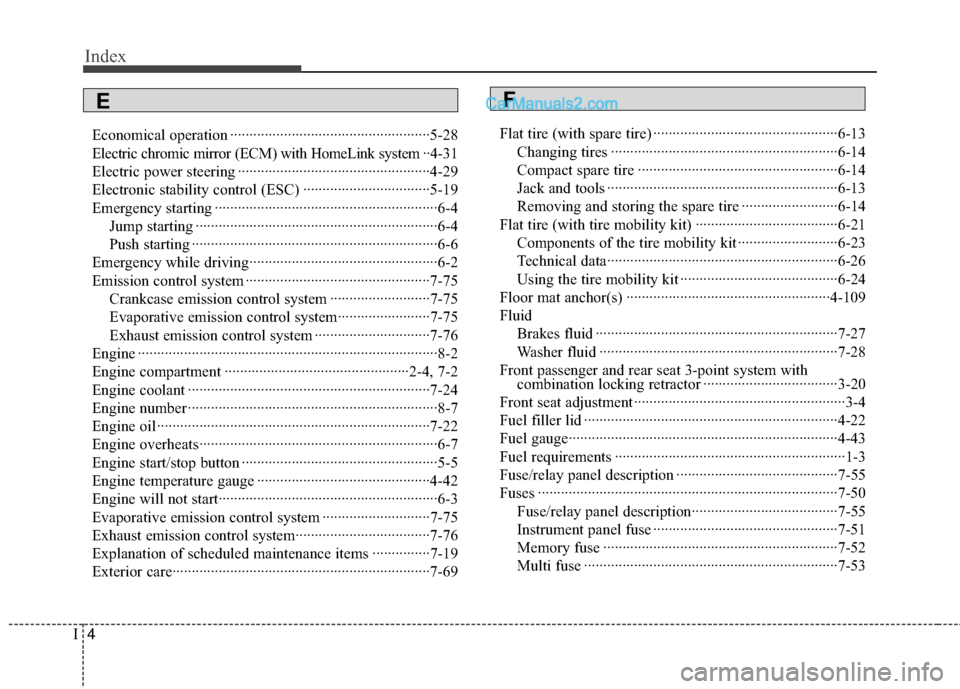
Index
4I
Economical operation ··················\
··················\
················5-28
Electric chromic mirror (ECM) with HomeLink system ··4-31
Electric power steering ··················\
··················\
··············4-29
Electronic stability control (ESC) ··················\
···············5-19
Emergency starting ··················\
··················\
··················\
····6-4 Jump starting ··················\
··················\
··················\
·········6-4
Push starting ··················\
··················\
··················\
··········6-6
Emergency while driving··················\
··················\
·············6-2
Emission control system ··················\
··················\
············7-75 Crankcase emission control system ··················\
········7-75
Evaporative emission control system··················\
······7-75
Exhaust emission control system ··················\
············7-76
Engine ··················\
··················\
··················\
··················\
······8-2
Engine compartment ··················\
··················\
············2-4, 7-2
Engine coolant ··················\
··················\
··················\
·········7-24
Engine number ··················\
··················\
··················\
···········8-7
Engine oil ··················\
··················\
··················\
·················7-22\
Engine overheats··················\
··················\
··················\
········6-7
Engine start/stop button ··················\
··················\
···············5-5
Engine temperature gauge ··················\
··················\
·········4-42
Engine will not start··················\
··················\
··················\
···6-3
Evaporative emission control system ··················\
··········7-75
Exhaust emission control system··················\
·················7-76\
Explanation of scheduled maintenance items ···············7-19
Exterior care··················\
··················\
··················\
·············7-69 Flat tire (with spare tire) ··················\
··················\
············6-13
Changing tires ··················\
··················\
··················\
·····6-14
Compact spare tire ··················\
··················\
················6-14
Jack and tools ··················\
··················\
··················\
······6-13
Removing and storing the spare tire ··················\
·······6-14
Flat tire (with tire mobility kit) ··················\
··················\
·6-21 Components of the tire mobility kit ··················\
········6-23
Technical data··················\
··················\
··················\
······6-26
Using the tire mobility kit ··················\
··················\
·····6-24
Floor mat anchor(s) ··················\
··················\
·················4-10\
9
Fluid Brakes fluid ··················\
··················\
··················\
·········7-27
Washer fluid ··················\
··················\
··················\
········7-28
Front passenger and rear seat 3-point system with combination locking retractor ··················\
·················3-20\
Front seat adjustment ··················\
··················\
··················\
·3-4
Fuel filler lid ··················\
··················\
··················\
············4-22
Fuel gauge··················\
··················\
··················\
················4-43
Fuel requirements ··················\
··················\
··················\
······1-3
Fuse/relay panel description ··················\
··················\
······7-55
Fuses ··················\
··················\
··················\
··················\
······7-50 Fuse/relay panel description··················\
··················\
··7-55
Instrument panel fuse ··················\
··················\
············7-51
Memory fuse ··················\
··················\
··················\
·······7-52
Multi fuse ··················\
··················\
··················\
············7-53
EF
Page 401 of 403
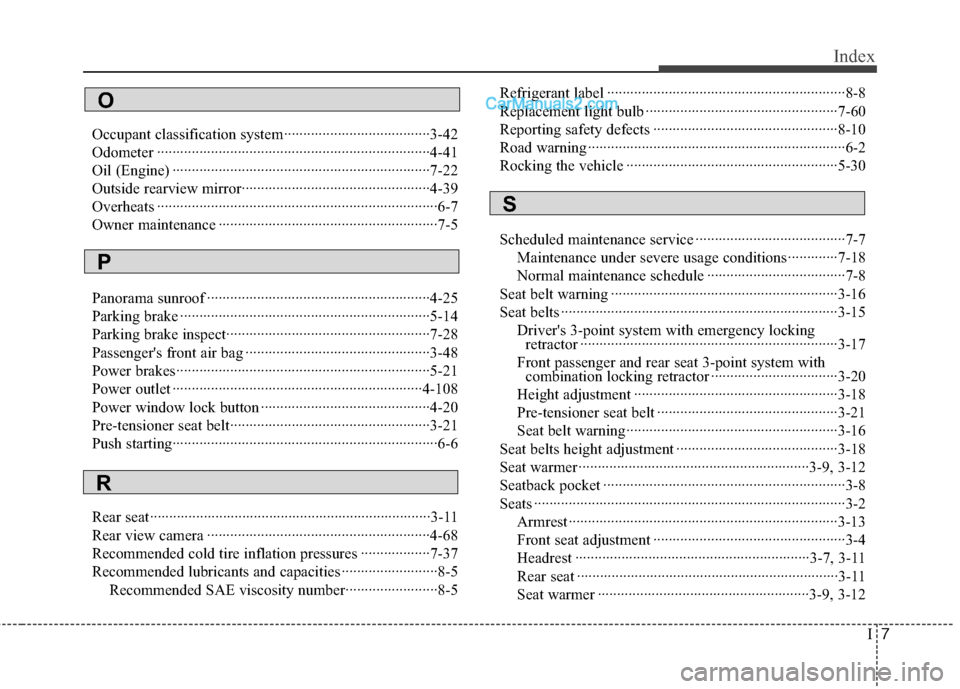
I7
Index
Occupant classification system··················\
··················\
··3-42
Odometer ··················\
··················\
··················\
·················4-41\
Oil (Engine) ··················\
··················\
··················\
·············7-22
Outside rearview mirror··················\
··················\
·············4-39
Overheats ··················\
··················\
··················\
··················\
·6-7
Owner maintenance ··················\
··················\
··················\
···7-5
Panorama sunroof ··················\
··················\
··················\
····4-25
Parking brake ··················\
··················\
··················\
···········5-14
Parking brake inspect··················\
··················\
·················7-28\
Passenger's front air bag ··················\
··················\
············3-48
Power brakes··················\
··················\
··················\
············5-21
Power outlet ··················\
··················\
··················\
···········4-108
Power window lock button ··················\
··················\
········4-20
Pre-tensioner seat belt··················\
··················\
················3-21
Push starting··················\
··················\
··················\
···············6-6
Rear seat··················\
··················\
··················\
··················\
·3-11
Rear view camera ··················\
··················\
··················\
····4-68
Recommended cold tire inflation pressures ··················\
7-37
Recommended lubricants and capacities ··················\
·······8-5Recommended SAE viscosity number··················\
······8-5 Refrigerant label ··················\
··················\
··················\
········8-8
Replacement light bulb ··················\
··················\
··············7-60
Reporting safety defects ··················\
··················\
············8-10
Road warning ··················\
··················\
··················\
·············6-2
Rocking the vehicle ··················\
··················\
··················\
·5-30
Scheduled maintenance service ··················\
··················\
···7-7
Maintenance under severe usage conditions ·············7-18
Normal maintenance schedule ··················\
··················\
7-8
Seat belt warning ··················\
··················\
··················\
·····3-16
Seat belts ··················\
··················\
··················\
··················\
3-15 Driver's 3-point system with emergency locking retractor ··················\
··················\
··················\
·············3-17
Front passenger and rear seat 3-point system with combination locking retractor ··················\
···············3-20
Height adjustment ··················\
··················\
·················3-18\
Pre-tensioner seat belt ··················\
··················\
···········3-21
Seat belt warning··················\
··················\
··················\
·3-16
Seat belts height adjustment ··················\
··················\
······3-18
Seat warmer ··················\
··················\
··················\
······3-9, 3-12
Seatback pocket ··················\
··················\
··················\
·········3-8
Seats ··················\
··················\
··················\
··················\
·········3-2 Armrest ··················\
··················\
··················\
················3-13
Front seat adjustment ··················\
··················\
··············3-4
Headrest ··················\
··················\
··················\
·······3-7, 3-11
Rear seat ··················\
··················\
··················\
··············3-11
Seat warmer ··················\
··················\
··················\
·3-9, 3-12
P
R
S
O